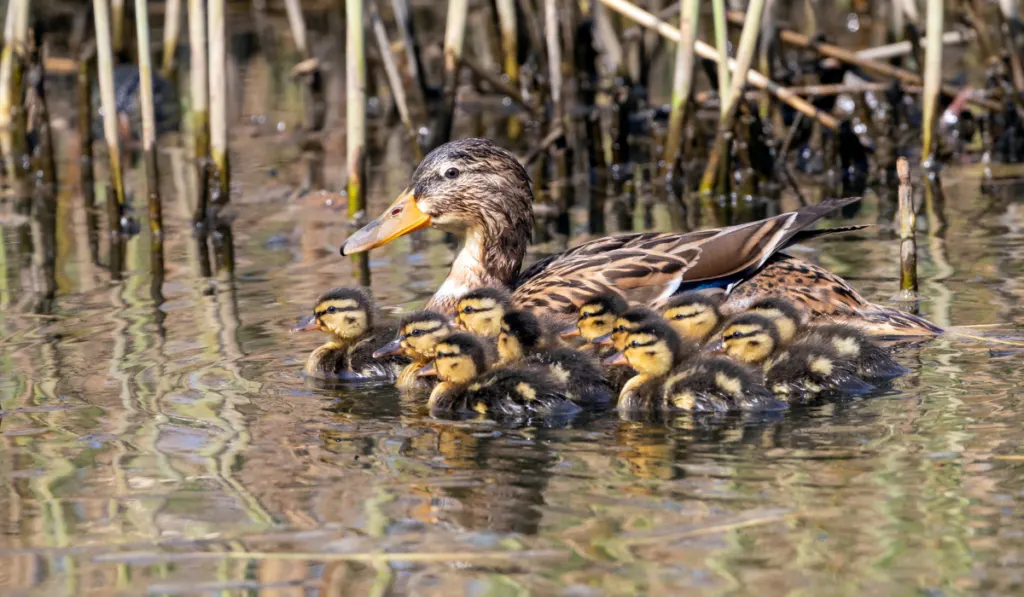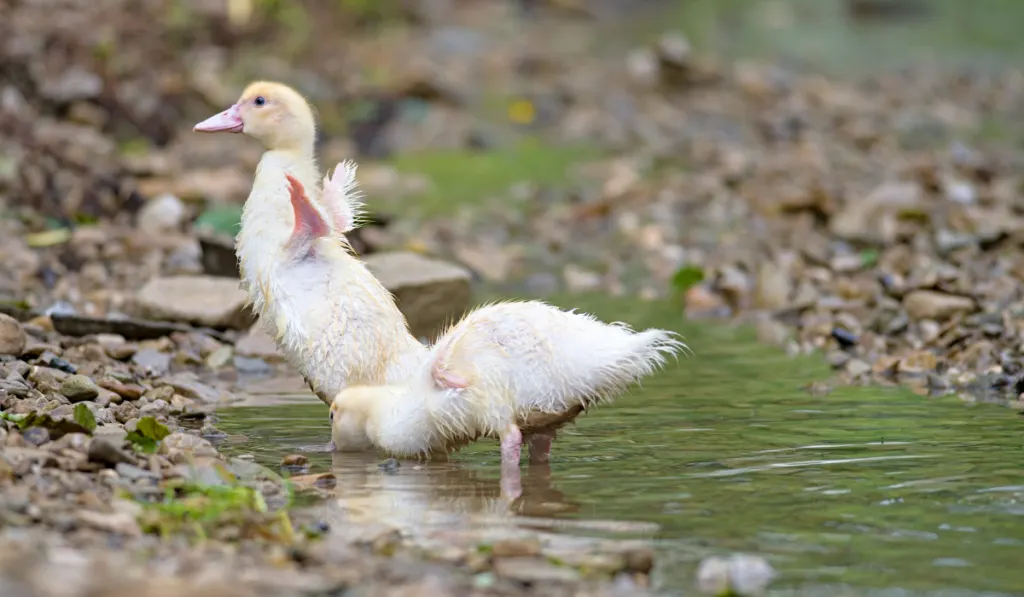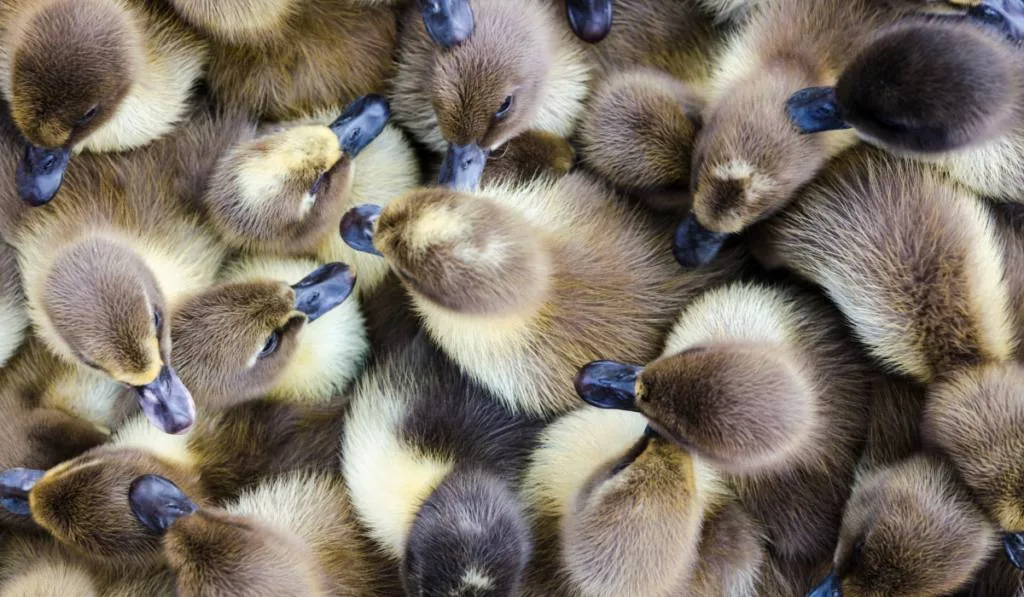As cute as they are, ducklings are often quite messy. While you may want them to move outside as soon as possible, the last thing you’d want is your ducklings outside prematurely.
Hence, it’s important to evaluate your ducklings’ living environment before letting them move outside.
Ducklings can start going outside on warm days when they are 3-5 weeks old, provided you keep them safe from predators.
Ducklings can move outside permanently any time after they reach four weeks old or are fully feathered and provided the nighttime temperature is not lower than 50° F.
However, when your duckling is ready to move outside depends on various factors such as the area you live in and the condition of your duckling. It’s important to ensure that each duckling’s needs are met before letting it move outside.

Table of Contents
Things to consider before letting your duckling move outside
Few things are more fun in life than raising ducklings, finding them cute baby duck names, and watching them grow. Here are some factors to take into consideration before letting your duckling move outside.
Duckling’s feathers
If your duckling does not have feathers yet, they are unable to move outside because they’ll need warm protection until their feathers arrive and can help regulate their temperature.
A duckling without its feathers will likely get cold easily and should be kept in temperatures of 50 degrees or higher.
Temperature inside and outside the brooder
During your duckling’s first week, the temperature in the brooder needs to be 90 degrees.
After the first week, you will need to lower the temperate by one degree each day until the temperature inside the brooder and the low temperature outside the brooder are the same.
Once the temperature inside and outside the brooder is the same, the ducklings can be transferred to a predator-proof shelter outside.
Due to the fact that ducklings only become fully feathered after they are 7 weeks old, when they can go outside will be based on your specific location.
Ducklings should not go outside if the temperatures are below 50 degrees. When your ducklings are 3-5 weeks old, they can spend time outside on warm days, provided they are adequately protected from predators and carefully supervised.
If your ducklings are older than 4 weeks, have all their feathers, or you are living in a climate with temperatures of 50 degrees or higher, then your ducklings can be placed in their permanent home outside.
Duckling’s ability to drink water
Ducklings who a mother duck hatches have oil glands to coat and waterproof their feathers, preventing them from becoming waterlogged and drowning.
However, ducklings hatched in an incubator do not have oil glands working to coat and waterproof their feathers, making it easy for them to become waterlogged and drown.
In this regard, it is ideal to use a shallow bowl for water so that they can submerge their entire bill to ensure their mucous membranes stay moist, but will not fall into the bowl and drown.
When the ducklings get bigger, you can consider adding marbles or stones to a slightly deeper water dish to prevent the ducklings from drowning in the dish.
It is crucial that you choose a water bowl that cannot be tipped over as ducklings can be very messy and will likely mess around in the water.
If you are concerned about your duckling’s ability to drink water safely, see this as an indication that your duckling may not be ready to move outside as they are still maturing.
Consider moving them outside when you are confident they can drink their water without potentially drowning.

Duckling’s ability to swim
Until ducklings are about 4 weeks old, they should only be allowed short, carefully supervised swims.
Consider filling a plastic tub with warm water and allowing the ducklings to splash around in the water for a few minutes, so they get used to being in water.
Once they are done swimming, be sure to dry them off and return them to the brooder, so they don’t get too cold.
If you are planning to move your ducklings outside, ensure that they are all able to swim and will not be at risk of drowning.
If you are not confident of their swimming skills, ensure that there are no drowning hazards in their outdoor shelter before moving them outside.
Suitable shelter when moving outside
If you feel your ducklings are ready to move outside, ensure that they will have a shelter that is sufficiently spacious, protects them from predators and inclement weather and heat.
The shelter should be spacious and be built securely enough to prevent predators from digging under the walls to gain entry.
Ensure that the shelter has solid latches to prevent predators from entering as well as to ensure that the ducklings don’t escape.
Additionally, the shelter should have windows to allow in natural light and bring in fresh air.
It is important that the shelter will provide good ventilation for your ducklings because ducklings exhale a lot of moisture.
That excess moisture has the potential to cause health problems if the shelter is not properly ventilated.
It is crucial that the outside shelter will meet all the ducklings’ needs before they move outside to prevent any unfortunate incidents from occurring down the line.
Space for ducklings
During their first two weeks of life, ducklings require ½ square foot of floor space per duckling. When they are one month old, they will need 1 square foot of floor space per ducking.
However, if your ducklings are to be completely confined after their first month, they will need 2 square feet of floor space per duckling.
Additionally, full-grown ducks require 4 square feet of floor space per duckling and require shelter that is at least 3 feet high.
In light of this, it is essential to consider the space available inside and outside before moving your ducklings as you don’t want them to be overcrowded both inside or outside.
Therefore it’s also important to take note of how big your ducklings are getting and whether their existing space is too cramped when determining whether they need to move outside.

Tips for maintaining ducklings
Here are some guidelines on how to take care of your ducklings.
DIY brooder
Need a brooder? Consider taking a cardboard box and lining it with plastic. Alternatively, use a bathtub as a brooder.
A bathtub is ideal as you can close the bathroom door to protect the ducklings from pets or children. A bathtub is also very easy to clean, which is important considering how messy having ducklings can get.
How to tell if ducklings are warm enough
In order to gauge if your ducklings are warm enough, you can monitor the duckling’s behavior and the thermometer in the brooder. If the ducklings are getting too cold, they will cluster around the heat source.
If the ducklings are warm enough, they will scamper around the brooder. However, if they are too warm, they will pant and distance themselves from the heat source, standing far away from the heat.
You can raise ducklings without a heat lamp as long as you take precautions to make sure they stay warm enough.
Adult ducks can tolerate cold better than ducklings.
When to Handle Ducklings
You should handle your ducklings as often as possible.
Play with them, cuddle them, talk to them and give them treats in order to build a good relationship with them. It’s vital that you educate your children on how to handle the ducklings.
Ensure that your children know to handle the ducklings gently and with care. Preferably, children should only handle the ducklings with adult supervision and be taught to be cautious not to drop them or feed them human food.
Conclusion
In the right environment, your ducklings will grow quickly into happy, healthy ducks. Enjoy the cute phase they are in as you prepare to move them outside.
Your ducklings should be ready to move outside when the temperature outside is no less than 50 degrees, they are older than 4 weeks, their feathers are growing nicely, and you have a secure, spacious shelter for them to stay in permanently.
Resources
- https://thecapecoop.com/ducklings-101/
- https://www.hgtv.com/outdoors/gardens/animals-and-wildlife/raising-ducks-caring-for-ducklings
- https://www.accidentalsmallholder.net/forum/index.php?topic=44107.0
- https://thefrugalchicken.com/how-to-raise-ducklings/
- https://alifeofheritage.com/farm-living/ducklings/
- https://www.beautyofbirds.com/caringforpoultrychicks.html
- https://farmhouseguide.com/web-stories/what-temperature-is-too-cold-for-ducks/
